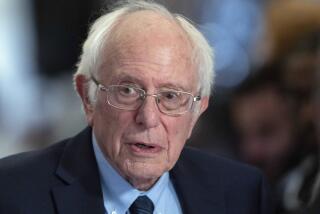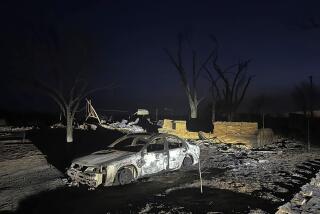A politician gets his way in New York fire
|
The Times' five-part series explores the growth and cost of wildfires. |
The 1995 Sunrise fire on Long Island is considered an extreme example of political interference in firefighting. Military cargo planes, mobilized at the insistence of a powerful U.S. senator, flew hundreds of miles to battle a fire that was almost out by the time they got there.
The fire started Aug. 24, 1995, in Westhampton, N.Y. Driven by wind and dry conditions, it raced through brushland and soon threatened some of Long Island’s most valuable real estate.
Harry Doughty, a state forester in Maine with extensive wildfire experience, was brought in to direct the aerial firefighting. He was confident that ground crews and the aircraft already on hand -- six small tankers and 12 helicopters -- were enough to control the fire.
U.S. Sen. Alfonse M. D’Amato and New York Gov. George Pataki thought otherwise. D’Amato, a Republican from Long Island, wanted military C-130s to bomb the fire with water or retardant. Pataki called President Clinton and later told the media that he had received assurances the C-130s were on the way.
D’Amato was leading the Senate investigation into Whitewater, the Arkansas real estate deal that was a focus of GOP attacks on Clinton and his wife, Hillary. The president, who was on a golf vacation in Wyoming, ordered a handful of top aides to Long Island with instructions to placate D’Amato.
James Lee Witt, director of the Federal Emergency Management Agency; Harold Ickes, deputy White House chief of staff; and James R. Lyons, undersecretary of Agriculture, boarded a FEMA plane in Washington in the middle of the night. Lyons went because he oversaw the Forest Service, the lead agency for fighting wildfires.
“D’Amato is there and meets us at the base of the plane in his fire chief’s jacket,” recalled Lyons, now a lecturer in resource management at Yale University. “Alfonse had it in his head that we needed big planes.”
D’Amato, who left the Senate in 1999 after losing his bid for a fourth term, declined to be interviewed for this article. Bill Clinton and Pataki did not respond to requests for comment.
In a makeshift command center near the fire, Doughty briefed the assembled officials and told D’Amato he had sufficient aircraft.
“The commander was the pro. He had sized up the situation and ordered small planes, the right size and right scale,” Lyons said. “D’Amato felt slighted that he didn’t get his big plane. He began shouting, ‘Get me planes, get me planes, get me planes!’ ”
Doughty stood his ground. Under federal firefighting protocols, only he or the incident commander could order planes or helicopters into action.
“I told them we didn’t need them,” said Doughty, who retired in 2000 after 26 years in Maine’s forest service. “I argued against it for a day and a half. It was obvious to the firefighters, but not to the political people.”
But Pataki and D’Amato believed they had a commitment from Clinton. Their credibility was at stake too: Both men had told the media that military planes were en route.
“This is where it got kind of silly,” Doughty recalled. “Jim Lyons came up to me and said, ‘I have a direct order from President Clinton. He wants you to order those aircraft.’ My first thought was, ‘I’m a state employee. I don’t work for Bill Clinton.’ But then I thought I’d want to continue my career.”
Doughty relented and called the National Interagency Fire Center in Boise, Idaho, to order the C-130s. “They said they had been waiting for my call,” he said.
Two C-130s with firefighting tanks were dispatched to New York from an Air National Guard base in North Carolina, along with a plane carrying support personnel.
The C-130s arrived on the morning of Aug. 26. By then, the fire had been contained, just as Doughty predicted.
Fire commanders searched for a still-active area of the fire where the planes could drop their loads. They chose a strip of burning grass beside a highway, with ample room for television trucks.
“We didn’t do any fire suppression in the area around the drop,” Doughty said. “It would have burned itself out.”
As the first C-130 started its run, a warning light came on in the cockpit and the plane had to land. After another delay, the second plane went up. The massive aircraft roared over its tiny target of smoldering grass and unleashed thousands of gallons of water.
“The news media were impressed. Everyone was happy,” Doughty said. “In my opinion, it was a waste of money. Think of the manpower to bring those planes in. It was a political thing, and it cost the taxpayers a lot of money.”
More to Read
Start your day right
Sign up for Essential California for news, features and recommendations from the L.A. Times and beyond in your inbox six days a week.
You may occasionally receive promotional content from the Los Angeles Times.







